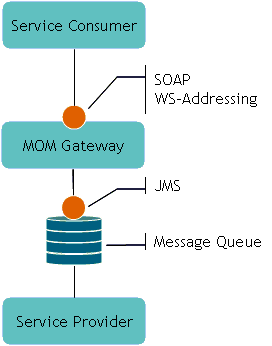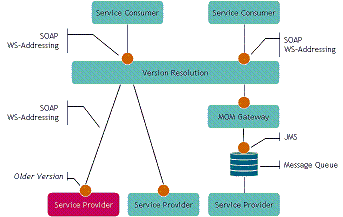The following InformationWeek article describes how GrandCentral (mentioned before in this blog) have added a raft of new partners, each offering different business services. I've included the following quote from the article and linked the references:
"In addition to NetSuite and NSite [note: NSite offer business automation services], Grand Central's partners include ServiceObjects, a customer-data-validation service; Demandware's E-commerce system; RecruitForce.com, an online system for managing job applicants and the application process; SPS Commerce, an EDI hosting service; StrikeIron, which provides tools to simplify publishing, finding, and utilizing Web services; and Xignite, a supplier of online financial services components.
Additional partners are: Moreover Technologies, a supplier of online news service systems; Advanous, a division of EnterBridge Technologies, supplier of an online distribution-management system; ExpediteBiz, an automated shipping-service supplier; OpenAir, an automated professional-services-management system; Intellibank, an online relationship-management system; and Advanced Data Exchange, an online EDI document-exchange service."
About the architecture that sits somewhere between the business processes and the code.
Monday, February 28, 2005
Saturday, February 19, 2005
Versioning Service II
In a previous blog, I started to explore the idea of how services could be versioned in a SOA. Although versioning the WSDL seemed to be an alternative for web services using SOAP the question remained on how to version services which use a queuing mechanism (e.g. with a JMS interface). If a service is invoked over a queue then the queue becomes synonymous with the service. All that has to happen is that new versions of a service are connected to new queues (appropriately named) . Old clients just stay connected to the old queues or are migrated to use the new services over the new queues. Seems easy, but I suspect that in a large system with many services it would be a nightmare to administer, especially as there is no lookup information for the queue. Indeed, this seems to depart from two of the main tenets of SOA, i.e. services are loosely coupled and that they can be discovered.
However, having previously discussed that versioning is possible in web services, can web services be combined with a queuing system and the advantages of web service versioning kept? New standards in the web services space seem to point to a possible solution (as web service management vendors - such as Systinet - are keen to point out). The basic architecture seems to look like this:

SOAP Messages are sent to a MOM gateway, which extracts the messages, finds the queue and sends the message (maybe using JMS if it’s a J2EE implemetation) to a service provider. Messages sent back from the service provider are picked up by the gateway and send as a SOAP response back to the consumer. All the issues concerned with message correlation etc. are handled by the MOM gateway.
Not shown in this diagram is how to deal with an asynchronous style of communication. To solve this comes a small, and apparently unassuming, specification called WS-Addressing. This provides a uniform way of supplying the endpoint of a web service within the SOAP message rather than just using a URL. Although it seems to add complexity, the standard ends up providing extra flexibility and may well be the answer to dealing with versioning of services, but more about that later. In the case of asynchronous messaging, WS-Addressing defines a "ReplyTo" SOAP header block and this could be the endpoint for the return message from the provider.
I have, for the time being, ignored the handling of publish/subscribe mechanisms. Within an SOA one would typically also architect an eventing mechanism, e.g. to notify that a change has happened to some data. WS-Eventing is maybe the right standard to use, but I not going into that now.
Having seen how to use web services with MOMs, lets get back to the versioning problem. In order to find the correct version of a web service an additional degree of layering is required. I’ve tried to show this in the following diagram:

Now the usual parole is to say that the namespaces of the XML messages are versioned and that the version resolution layer checks the name space and directs the message to appropriate service. However, WS-Addressing offers another possibility. Instead of specifying the endpoint of the service provider the corresponding endpoint of the version resolution system is specified plus versioning information. Based on this, the version resolution finds the correct endpoint, modifies the endpoint in the WS-Addressing part of the SOAP header and directs the message to this.
Nobody seems to be actually offering anything in this area, although application platform vendors such as BEA seem to be active in terms of XML versioning, but if they are going to use WS-Addressing in their products to implement versioning , remains open. Web services management vendors such as AmberPoint , also seem to offer support for service versioning with their products, although how far this goes and if it is based on open standards is unclear.
However, having previously discussed that versioning is possible in web services, can web services be combined with a queuing system and the advantages of web service versioning kept? New standards in the web services space seem to point to a possible solution (as web service management vendors - such as Systinet - are keen to point out). The basic architecture seems to look like this:

SOAP Messages are sent to a MOM gateway, which extracts the messages, finds the queue and sends the message (maybe using JMS if it’s a J2EE implemetation) to a service provider. Messages sent back from the service provider are picked up by the gateway and send as a SOAP response back to the consumer. All the issues concerned with message correlation etc. are handled by the MOM gateway.
Not shown in this diagram is how to deal with an asynchronous style of communication. To solve this comes a small, and apparently unassuming, specification called WS-Addressing. This provides a uniform way of supplying the endpoint of a web service within the SOAP message rather than just using a URL. Although it seems to add complexity, the standard ends up providing extra flexibility and may well be the answer to dealing with versioning of services, but more about that later. In the case of asynchronous messaging, WS-Addressing defines a "ReplyTo" SOAP header block and this could be the endpoint for the return message from the provider.
I have, for the time being, ignored the handling of publish/subscribe mechanisms. Within an SOA one would typically also architect an eventing mechanism, e.g. to notify that a change has happened to some data. WS-Eventing is maybe the right standard to use, but I not going into that now.
Having seen how to use web services with MOMs, lets get back to the versioning problem. In order to find the correct version of a web service an additional degree of layering is required. I’ve tried to show this in the following diagram:

Now the usual parole is to say that the namespaces of the XML messages are versioned and that the version resolution layer checks the name space and directs the message to appropriate service. However, WS-Addressing offers another possibility. Instead of specifying the endpoint of the service provider the corresponding endpoint of the version resolution system is specified plus versioning information. Based on this, the version resolution finds the correct endpoint, modifies the endpoint in the WS-Addressing part of the SOAP header and directs the message to this.
Nobody seems to be actually offering anything in this area, although application platform vendors such as BEA seem to be active in terms of XML versioning, but if they are going to use WS-Addressing in their products to implement versioning , remains open. Web services management vendors such as AmberPoint , also seem to offer support for service versioning with their products, although how far this goes and if it is based on open standards is unclear.
Friday, February 18, 2005
Extending XML Schemas
Interesting article about how to write XML Schemas which can be extended. Extending the schema doesn't remove the need for versioning, but it goes some way in preserving loose coupling.
Thursday, February 17, 2005
For the Web Service Challenged
Having problems keeping a track on all those web service standards.? Maybe these 3 help:
- IBM keep a list of web service standards as well as their current status. Unfortunately these only seem to be those which IBM was involved in (including organisations such as OASIS and w3C).
- Microsoft also keep a list, but in a more verbose fashion and, like IBM, it seems to be focused on Microsoft efforts.
- Wikipedia also has a list of web service standards, but currently does not show the status.
Thursday, February 10, 2005
Business Process Handbook
The MIT Process Handbook is a catalog of processes, arranged in a hierarchical structure. Rather than just letting you examine the processes it also lets you generate ideas (based on related processes), which could be used to improve them.
A book is also available that explains the concepts behind it: Organizing Business Knowledge: The MIT Process Handbook
by Thomas W. Malone, Kevin Crowston and George A. Herman - ISBN:0262134292
A book is also available that explains the concepts behind it: Organizing Business Knowledge: The MIT Process Handbook
by Thomas W. Malone, Kevin Crowston and George A. Herman - ISBN:0262134292
Tuesday, February 08, 2005
Building an Enterprise using Hosted Services III
Subscribe to:
Comments (Atom)